
Iberulites are a particular type of microspherulites (Fig. 1) that develop in the atmosphere (troposphere), finally falling to the Earth's surface. The name comes from the Iberian Peninsula where they were discovered. [1]

Iberulites are a particular type of microspherulites (Fig. 1) that develop in the atmosphere (troposphere), finally falling to the Earth's surface. The name comes from the Iberian Peninsula where they were discovered. [1]
An iberulite is a co-association [2] [note 1] with axial geometry, consisting of well-defined mineral grains, together with non-crystalline compounds, structured around a coarse-grained core with a smectite rind, only one vortex and pinkish color (Figs. 1-2), formed in the troposphere by complex aerosol-water-gas interactions.

These microspherulites are mostly spherical in shape (roundness index=0.95), with 60-90 μm modal diameter, although some particles can be up to 200 μm in diameter. [3] According to this roundness index, these microspherules are really elongated spheroids with two axes defined along a polar plane and typically presenting a depression or vortex. The presence of plant filaments in the atmosphere can distort these shapes and sizes. In any case, these are uncommon “giant” aerosol particles.
Composition can be determined by both X-ray diffraction (XRD) and electronic microscopy techniques (mainly SEM, EDX, HRTEM). Sections show that the body of iberulites can be divided into core and rind. The core is mainly formed by grains of quartz, calcite, dolomite and feldspars. The rind shows clay minerals, mainly smectites (beidellite, montmorillonite) and illite, as well as sulfates, chlorides and amorphous silica. The latter group of minerals could be the result of neoformations during the maturation process occurring in the atmosphere during the final stages of iberulite formation. It is striking that sulphates only appear in the periphery of the iberulites. [3] Flight over areas with anthropogenic or natural (volcanic, as those of North Atlantic archipelagos) [note 2] sulphur emissions probably adsorbs SO2 onto the iberulite surface. Descent to the marine boundary layer (MBL) [4] [note 3] of the Iberian-Moroccan Atlantic coast leads to the incorporation of sea salt and microorganisms. The iberulites eventually fall on the southern Iberian Peninsula, where they have been detected.

Iberulites have as yet only been found in the southern Iberian Peninsula. This location is geographically close to North Africa and it is therefore influenced by the emissions of Saharan aerosols, which are the greatest contributor of particulate matter to the atmospheric global dust budget [5] (Fig. 3).

The general content of aerosols in the atmosphere of the southern Iberian Peninsula is clearly related to the evolution of aerosols arriving from North Africa. [6] Monitoring of dry aerosol deposition using passive samplers determined the formation of iberulites in two periods of the year (Fig. 4). The main depositional period occurs throughout the summer, while the second appears as a minor peak in early spring. However, the formation of iberulites is more specifically related with Saharan dust outbreaks, or dust plumes (Fig. 5) occurring within these two defined periods. [6]


Short episodes of wet deposition (more specifically red rains) were observed [6] during Saharan dust outbreaks over the period 2004-2013. Monitoring of these episodes led to the obtaining of a sequence of droplet impacts (Fig. 6) corresponding to June 6, 2012. This sequence would have begun with the formation of more or less aerosol-rich water droplets (or precursor water droplets [7] ) (Fig. 6A). The aerosol contents, together with dissolved salts (detected in this sequence as whitish or shiny precipitates), would have gradually increased, finally producing a well-defined iberulite after desiccation (Fig. 6E). The passage of these Saharan dust outbreaks over the study site had a total mean duration of five days (Fig. 7). It was observed during this passage that the central day presented the highest air temperatures and PM10 and PM2.5 (PM10>PM2.5) contents, whereas relative humidity decreased (RH). A relation was therefore established between monthly numbers of iberulite episodes and PM10 content-RH, which determined that clean atmospheres (<5 μg•m-3) with RH>65% do not present suitable conditions for iberulite formation. [6]

Iberulites are linked to the evolution of high-dust air masses (plumes) which, originating in Saharan dust storms, are transported over the Iberian Peninsula and often across the eastern North Atlantic Ocean. These plumes occur in the warm season (May to September), as a result of anticyclone activity affecting the Iberian Peninsula, and only sporadically in spring. Based on the relation between iberulites and red rain events, as well as the morphologies and compositional attributes observed, an aqueous interphase hypothesis has been suggested as the unitary mechanism for tropospheric formation of iberulites. [1] [3] [6] Interactions between water droplets and Saharan aerosols create complex hydrodynamic conditions [7] causing the possibility of collisions (wake capture and front capture) [note 4] that originate the "precursor water droplets" of the iberulites. [1] [3] [6] The movement of these water droplets to lower tropospheric levels implies either simultaneous or consecutive processes such as coalescence, formation of vortex and downdraught. During this phase the iberulites acquire their spherical shape and internal structure (core and rind), although sometimes this shape can be distorted.
There is an additional process of atmospheric maturation of iberulites that, in detail, only happens on the smectite rind, by means of heterogeneous and multiphase reactions [note 5] producing sulfates as the result of H2SO4 attack on the minerals of the rind. This would lead to the rapid transformation of some primary minerals into products of atmospheric neoformation [note 6] secondary minerals): the sulfates (mainly the gypsum) would be the product of H2SO4 attack on the interlayer cations of the smectites, which would gradually destroy the octahedral and tetrahedral [note 7] sheets of phyllosilicates creating mixed sulfates.
The alunite - jarosite found in the smectite rind would have a similar origin. If acid attack progresses further, the phyllosilicate grains would be completely destroyed, producing amorphous silica and releasing iron. Since biogenic exoskeletons have no signs of corrosion, they must have been incorporated after the acid attack described above, probably simultaneously with the incorporation of sea salt.
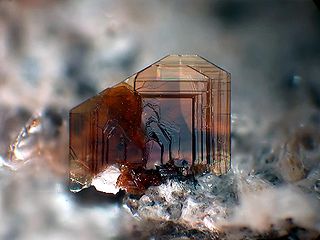
Biotite is a common group of phyllosilicate minerals within the mica group, with the approximate chemical formula K(Mg,Fe)3AlSi3O10(F,OH)2. It is primarily a solid-solution series between the iron-endmember annite, and the magnesium-endmember phlogopite; more aluminous end-members include siderophyllite and eastonite. Biotite was regarded as a mineral species by the International Mineralogical Association until 1998, when its status was changed to a mineral group. The term biotite is still used to describe unanalysed dark micas in the field. Biotite was named by J.F.L. Hausmann in 1847 in honor of the French physicist Jean-Baptiste Biot, who performed early research into the many optical properties of mica.
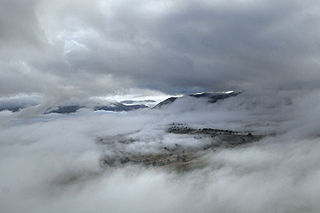
An aerosol is a suspension of fine solid particles or liquid droplets in air or another gas. Aerosols can be natural or anthropogenic. The term aerosol commonly refers to the particulate/air mixture, as opposed to the particulate matter alone. Examples of natural aerosols are fog or mist, dust, forest exudates, and geyser steam. Examples of anthropogenic aerosols include particulate air pollutants, mist from the discharge at hydroelectric dams, irrigation mist, perfume from atomizers, smoke, dust, steam from a kettle, sprayed pesticides, and medical treatments for respiratory illnesses. When a person inhales the contents of a vape pen or e-cigarette, they are inhaling an anthropogenic aerosol.

Bentonite is an absorbent swelling clay consisting mostly of montmorillonite which can either be Na-montmorillonite or Ca-montmorillonite. Na-montmorillonite has a considerably greater swelling capacity than Ca-montmorillonite.
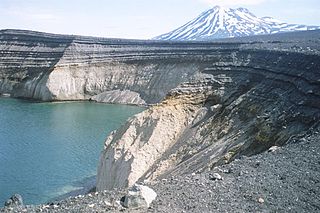
The Aleutian Range is a major mountain range located in southwest Alaska. It extends from Chakachamna Lake to Unimak Island, which is at the tip of the Alaska Peninsula. It includes all of the mountains of the Peninsula. The Aleutian Range is special because of its large number of active volcanoes, which are also part of the larger Aleutian Arc. The mainland part of the range is about 600 miles (1000 km) long. The Aleutian Islands are (geologically) a partially submerged western extension of the range that stretches for another 1,600 km (1000 mi). However the official designation "Aleutian Range" includes only the mainland peaks and the peaks on Unimak Island. The range is almost entirely roadless wilderness. Katmai National Park and Preserve, a large national park within the range, must be reached by boat or plane.
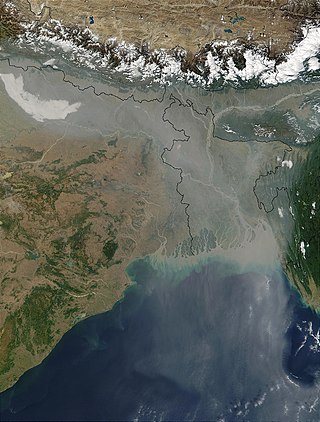
Cloud condensation nuclei (CCNs), also known as cloud seeds, are small particles typically 0.2 µm, or one hundredth the size of a cloud droplet. CCNs are a unique subset of aerosols in the atmosphere on which water vapour condenses. This can affect the radiative properties of clouds and the overall atmosphere. Water requires a non-gaseous surface to make the transition from a vapour to a liquid; this process is called condensation.
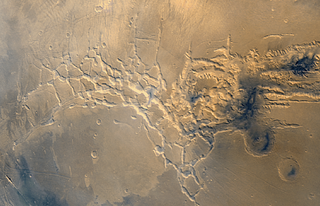
Noctis Labyrinthus is a region of Mars located in the Phoenicis Lacus quadrangle, between Valles Marineris and the Tharsis upland. The region is notable for its maze-like system of deep, steep-walled valleys. The valleys and canyons of this region formed by faulting and many show classic features of grabens, with the upland plain surface preserved on the valley floor. In some places the valley floors are rougher, disturbed by landslides, and there are places where the land appears to have sunk down into pit-like formations. It is thought that this faulting was triggered by volcanic activity in the Tharsis region. Research described in December 2009 found a variety of minerals, including clays, sulfates, and hydrated silicas, in some of the layers.

Clay minerals are hydrous aluminium phyllosilicates (e.g. kaolin, Al2Si2O5(OH)4), sometimes with variable amounts of iron, magnesium, alkali metals, alkaline earths, and other cations found on or near some planetary surfaces.

Montmorillonite is a very soft phyllosilicate group of minerals that form when they precipitate from water solution as microscopic crystals, known as clay. It is named after Montmorillon in France. Montmorillonite, a member of the smectite group, is a 2:1 clay, meaning that it has two tetrahedral sheets of silica sandwiching a central octahedral sheet of alumina. The particles are plate-shaped with an average diameter around 1 μm and a thickness of 0.96 nm; magnification of about 25,000 times, using an electron microscope, is required to resolve individual clay particles. Members of this group include saponite, nontronite, beidellite, and hectorite.
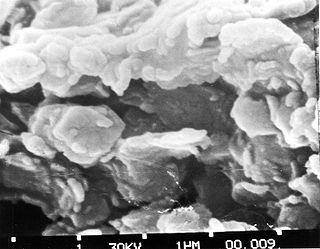
A smectite is a mineral mixture of various swelling sheet silicates (phyllosilicates), which have a three-layer 2:1 (TOT) structure and belong to the clay minerals. Smectites mainly consist of montmorillonite, but can often contain secondary minerals such as quartz and calcite.

The Compact Reconnaissance Imaging Spectrometer for Mars (CRISM) was a visible-infrared spectrometer aboard the Mars Reconnaissance Orbiter searching for mineralogic indications of past and present water on Mars. The CRISM instrument team comprised scientists from over ten universities and was led by principal investigator Scott Murchie. CRISM was designed, built, and tested by the Johns Hopkins University Applied Physics Laboratory.
Metakaolin is the anhydrous calcined form of the clay mineral kaolinite. Minerals that are rich in kaolinite are known as china clay or kaolin, traditionally used in the manufacture of porcelain. The particle size of metakaolin is smaller than cement particles, but not as fine as silica fume.

Nontronite is the iron(III) rich member of the smectite group of clay minerals. Nontronites typically have a chemical composition consisting of more than ~30% Fe2O3 and less than ~12% Al2O3 (ignited basis). Nontronite has very few economic deposits like montmorillonite. Like montmorillonite, nontronite can have variable amounts of adsorbed water associated with the interlayer surfaces and the exchange cations.

Mineral dust is atmospheric aerosol originated from the suspension of minerals constituting the soil, composed of various oxides and carbonates. Human activities lead to 30% of the airborne dust (particulates) load in the atmosphere. The Sahara Desert is the major source of mineral dust, which subsequently spreads across the Mediterranean and Caribbean seas into northern South America, Central America, and eastern North America, and Europe. Additionally, it plays a significant role in the nutrient inflow to the Amazon rainforest. The Gobi Desert is another source of dust in the atmosphere, which affects eastern Asia and western North America.

Bioaerosols are a subcategory of particles released from terrestrial and marine ecosystems into the atmosphere. They consist of both living and non-living components, such as fungi, pollen, bacteria and viruses. Common sources of bioaerosols include soil, water, and sewage.

Stratospheric aerosol injection is a proposed method of solar geoengineering to reduce global warming. This would introduce aerosols into the stratosphere to create a cooling effect via global dimming and increased albedo, which occurs naturally from volcanic winter. It appears that stratospheric aerosol injection, at a moderate intensity, could counter most changes to temperature and precipitation, take effect rapidly, have low direct implementation costs, and be reversible in its direct climatic effects. The Intergovernmental Panel on Climate Change concludes that it "is the most-researched [solar geoengineering] method, with high agreement that it could limit warming to below 1.5 °C (2.7 °F)." However, like other solar geoengineering approaches, stratospheric aerosol injection would do so imperfectly and other effects are possible, particularly if used in a suboptimal manner.
Microspherulites are microscopic spherical particles with diameter less than two mm, usually in the 100 micrometre range, mainly consisting of mineral material. Only bodies created by natural physico-chemical processes, with no contribution of either biological or human activity, are considered to be microspherulites. Generally speaking, the common feature (sphericity) indicates that each sphere represents an internal equilibrium of forces within a fluid medium.
The mineralogy of Mars is the chemical composition of rocks and soil that encompass the surface of Mars. Various orbital crafts have used spectroscopic methods to identify the signature of some minerals. The planetary landers performed concrete chemical analysis of the soil in rocks to further identify and confirm the presence of other minerals. The only samples of Martian rocks that are on Earth are in the form of meteorites. The elemental and atmospheric composition along with planetary conditions is essential in knowing what minerals can be formed from these base parts.

Particulates or atmospheric particulate matter are microscopic particles of solid or liquid matter suspended in the air. The term aerosol commonly refers to the particulate/air mixture, as opposed to the particulate matter alone. Sources of particulate matter can be natural or anthropogenic. They have impacts on climate and precipitation that adversely affect human health, in ways additional to direct inhalation.

The composition of Mars covers the branch of the geology of Mars that describes the make-up of the planet Mars.